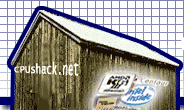


 |
 |
 |
| home | about | pictures | reference | trade | links |
INTEL DEBUTS 90- and 100-MHz PENTIUM(TM) PROCESSORS
Family Expands as Latest-Generation Processor Enters Retail Market
SANTA CLARA, Calif., March 7, 1994 -- Intel Corporation today announced the expansion of the Pentium(TM) processor family, the fastest desktop PC processors shipping today. The new 90- and 100-MHz family members, offering as much as 166 MIPS of processing performance, arrive as Pentium processor-based PCs are moving rapidly through all channels, including retail, with affordable price points for today's performance-oriented applications for the home and business user. The 100 MHz Pentium processor is nearly 175 percent faster than a 66 MHz IntelDX2(TM) processor. The new Pentium processors are built in two leading-edge Intel manufacturing facilities including Fab 10, a recently opened Ireland plant. The Pentium processor is on the most aggressive ramp in Intel's microprocessor history. As the next level of Pentium processor price/performance enters the systems marketplace, Intel has begun a $150 million 1994 Pentium processor marketing and advertising campaign that adds mass market retail channels for home PC buyers to traditional business-oriented marketing programs. "Higher-performance processors are entering the mainstream of the marketplace faster as the PC becomes a mass-market interactive home appliance," said Paul S. Otellini, senior vice president and co- general manager of Intel's Microprocessor Products Group. "The home PC spans entertainment, education, family business and home office uses -- all requiring the increasing levels of performance provided by the Pentium processor family."
Many Pentium processor-based PCs are priced well under $3,000, offering the best PC price/performance in the retail channel at affordable price points. This contrasts with past CPU generations in which this same level of affordability took as much as five years to achieve. Intel estimates that Pentium processor systems will account for 15 percent of 1994 shipments in the PC market segment, becoming 25 percent of Intel's shipments in Q4 and crossing over Intel486(TM) processors in 1995.
The Home Market
Converging on this rapid rate of Pentium processor deployment is
the continued growth of the home PC market, which last year accounted
for close to half the PCs sold. The home buyer's PC usage is
changing, driven in part by the growth of home-office computing. In
addition, multimedia applications sold in retail outlets, a boom in
subscriptions to on-line services and the overall penetration of
modems into the home market segment are further evidence of a movement
to higher-performance requirements for the home PC. Likewise, market
research shows that more than a third of the PCs sold into the home
market segment in 1993 were based on high-end Intel486 processors and
sold for the same prices at which Pentium processor-based PCs are
emerging.
"Conventional wisdom says that the home PC market is served by a
low-end machine," Otellini said. "The facts are different, however.
Multimedia education and entertainment applications are key pieces of
the home PC marketplace and they require CPU performance as well as a
robust system design."
"Pentium processor-based systems provide all these features
without sacrificing software compatibility with more than 50,000
applications ranging from business to games packages," said Albert Yu,
senior vice president and co-general manager of the Microprocessor
Products Group. "In addition, this compatibility and the future
upgradability of Pentium processor system designs offer the investment
protection consumers need."
Intel is working cooperatively with OEMs and retailers worldwide
to promote their Pentium processor systems to consumers as part of a
$150 million marketing campaign. Print and television ads will run in
the U.S. and Europe beginning this month.
New Processors
The two new Pentium processors introduced today operate at 90 MHz
and 100 MHz frequencies. For performance comparisons, the processors
have ratings of 735 and -
815, respectively, on Intel's consumer-oriented iCOMP(TM) index of
processor performance and Specint92 ratings of 90 and 100. The 90-MHz
processor is priced at $849 and the 100-MHz CPU is $995 in quantities
of 1,000 pieces.
The extensions to the Pentium processor family take advantage of
a new 0.6-micron (a micron is about 1/100th the diameter of a human
hair) manufacturing process that allows Intel engineers to increase
performance and reduce costs.
This same technology is being used to produce the IntelDX4(TM)
processor family, also announced today. A 100-MHz IntelDX4 processor
has an iCOMP rating of 435 (Specint92 51.4) and a 75-MHz version is
319 on the Intel performance scale. The IntelDX4 processors offer up
to 50 percent more performance than the IntelDX2(TM) processor using
essentially the same system design.
"The world's best performing notebooks are based on the IntelDX4
processor," Yu said. "Mobile computer users, for the first time, can
get the same level of performance as desktop users without
compromising battery life."
The 75 MHz IntelDX4 processor is $475 and the 100 MHz IntelDX4
processor is $580 each in 1,000-piece quantities.
Intel, the world's largest chip maker, is also a leading
manufacturer of personal computer, networking and communications
products.